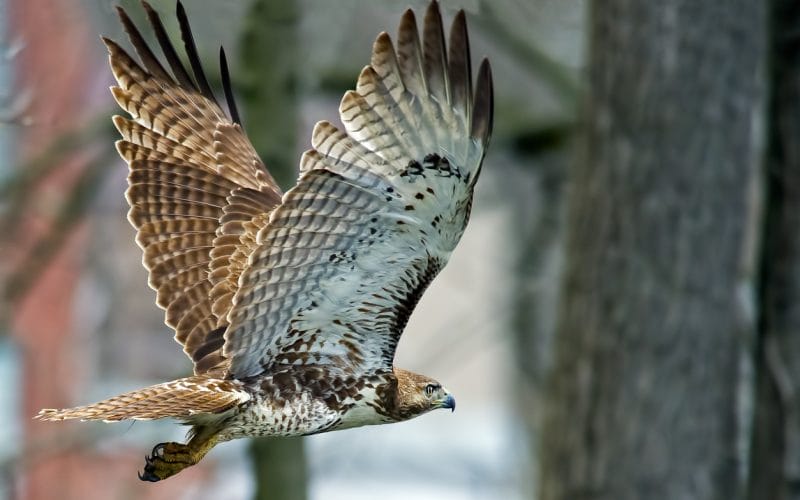Fun fact: the Mid-Atlantic state, Maryland is not only the birthplace of the U.S. national anthem but is also home to various predatory birds.
On average, the number of predatory birds in Maryland is 15. These raptors are called predatory because they feed on fellow birds, vertebrae, and often harm humans too.
That being said, how can you identify the 15 Maryland birds of prey? Look no further because we’ve put together this guide to help you recognize any of these birds from their most definitive features.
Let’s begin, shall we?
Maryland’s Hawks
Hawks are the commonly found predatory bird in Maryland. Below, you’ll find Maryland’s 5 most famous hawks.
1. The Red-Tailed Hawk

This hawk species is first on the list as it’s the most common predatory bird found in Maryland. They’re often spotted circling over the open, wide fields of the state, searching for their prey.
Top Tip: This hawk can only be identified by its short and wide, red tail—from which it gets its name.
In addition, Red-tailed Hawks are highly adaptable to multiple environments and can be found flying about all year round. They’re also highly defensive of their territories.
Finally, the typical feed of a Red-tailed Hawk includes small mammals such as rodents and voles. Their diet also consists of reptiles and other birds. That’s why they don’t frequent bird feeders or people’s backyards.
2. Sharp-Shinned Hawk
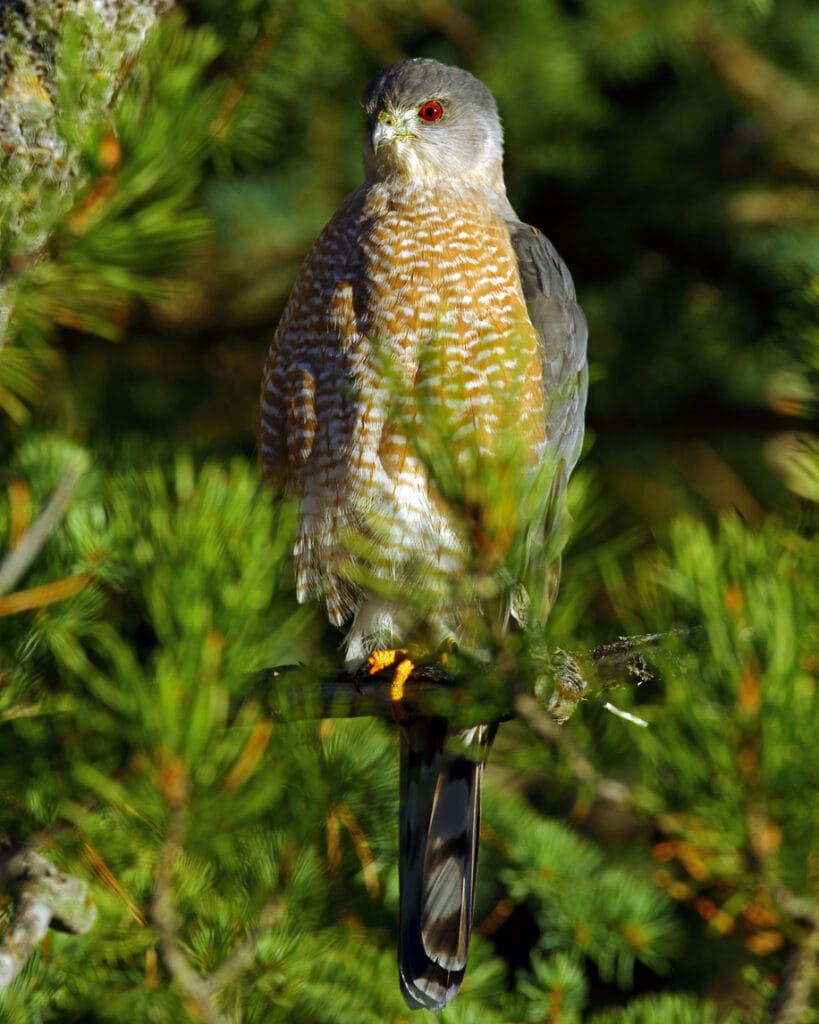
The other most frequently found hawk in Maryland’s northeastern forests is the Sharp-shinned Hawk. These hawks are often spotted speeding through thick trees, undetected by their prey.
Because of their high speed and ninja-like skills, the Sharp-shinned Hawk rightfully earned its name. These aerobatic skills come as a result of their small size, short rounded wings, and long tail.
In addition, Sharp-shinned Hawks are easily recognized by their orange-feathered chest. This doesn’t make them less of an ambush predator, however. They still use their stealth skills to attack smaller birds.
So, this hawk wouldn’t shy away from your bird feeder to prey on songbirds there, such as morning doves. And because they’re highly adaptable and don’t migrate much, they’ll be an all-year-round problem.
3. Cooper’s Hawk

The Cooper’s Hawk takes a lot after the Sharp-shinned one. That’s because both birds have similarly colored feathers and hunt using the same stealthy methods. Not only that, but both hawks frequent the woodlands of Maryland.
However, there’s one way to differentiate between them, and that’s by their size. The cooper’s hawk is relatively larger than the small-yet-deadly Sharp-shinned one. When they’re in-flight, though, it’d be hard to know which is which.
The Cooper’s Hawk also follows the same diet as its sister since it too feeds on songbirds such as the Common Starling. That’s why this hawk is often spotted whenever it’s involved in high-speed races to catch its prey.
4. Red-Shouldered Hawk
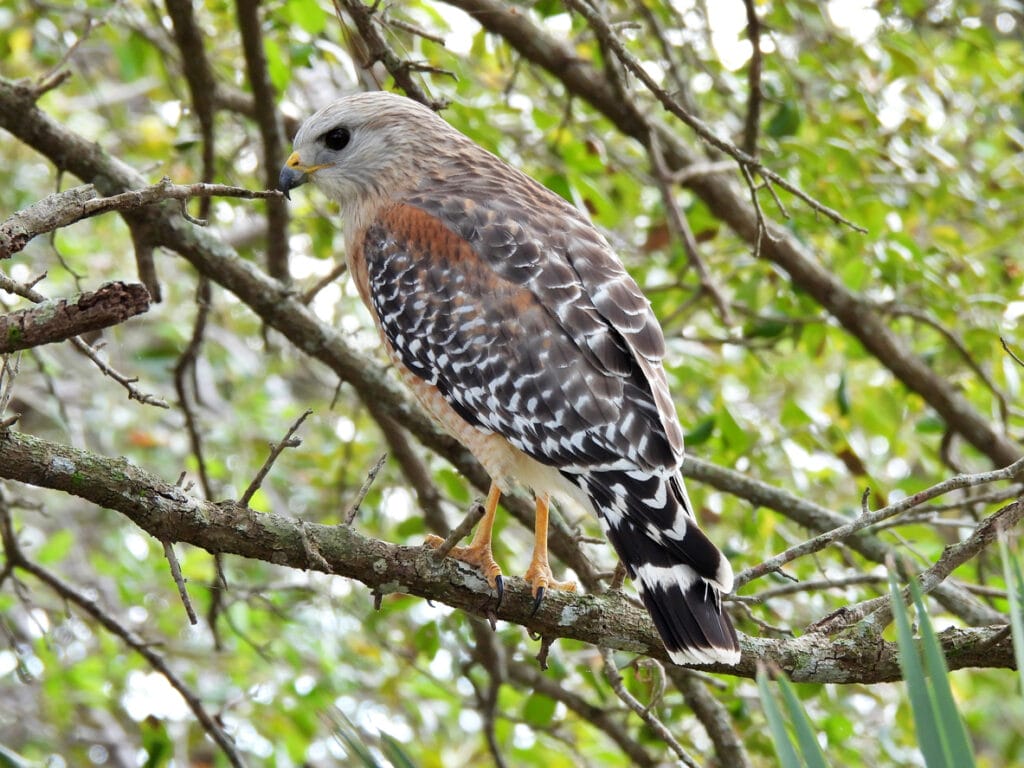
The Red-shouldered Hawk gets the name from its rusty brown wings which look like red-colored shoulders when the bird’s standing straight. Their bodies are also huge and have wide wingspans.
The Red-shouldered Hawk lives its 2-year life, dwelling in suburban woodlands. They’re also protective of their nesting areas and would fight off bigger birds and even humans if they come threateningly close.
Speaking of fighting, the Red-shouldered Hawk has a unique attack style as these birds usually charge at their preys head-on. On that note, their diets consist mostly of small birds, mammals, amphibians, and reptiles.
Author Note: In addition, the Red-shouldered Hawk isn’t only frequent in Maryland, but can also be found along the coastline of California and east of the Mississippi River.
5. Rough-Legged Hawk

This hawk is described as rough-legged since its legs and toes are completely covered in feathers. This feature isn’t characteristic of many hawks. In fact, only the Ferruginous Hawk shares this trait too.
That being said, the Rough-legged Hawk travels around Maryland throughout the year. During the winter, they head south, and when breeding, they’re found in the central regions of the state.
The Rough-legged Hawk is also quite chunky. As a result, this hawk favors open fields where they can hover and fly freely. Plus, to make up for the disadvantage of having big bodies, this bird typically hunts in silence.
Also, a Rough-legged Hawk usually lives up to 18 years. In addition, their bodies are dark brown with black and white spots. Finally, their diets consist of small rodents and ground squirrels. They also typically hunt from dusk till dawn.
Maryland’s Owls
Let’s agree that owls are royally looking creatures, and thankfully, Maryland is full of them. Read on to know the 5 owls of Maryland.
1. Great-Horned Owl

The ear tufts on this owl look like horns and that’s where it gets its name. The Great-horned Owl is also the most common and the biggest owl found in Maryland.
An interesting fact: birdwatchers have recognized the Great-horned Owl and the Red-tailed Hawk as nemeses. This is probably because they’re both environmentally adaptable, stay the year in Maryland, and also enjoy the same diets.
So, it’s only natural that each predatory bird feels threatened by the other. The only difference between both is their attack style. That’s because the Great-horned Owl is known to use its nature-colored feathers as camouflage to hide from its prey.
Another difference is that the Great-horned Owl has a weaker sense of smell than that of most predatory birds. That’s why they can even be seen eating skunks!
2. Barred Owls

These owls are labeled barred because of the stripes on their bodies that alternate between light and dark brown colors. The owl is also named ‘a hoot owl’ because its hooting sounds are very vocal.
That being said, the Barred Owl is known for its curiosity. As a result of this inquisitiveness, this owl likes to observe humans. Even if provoked, they’ll fly off and continue to watch you from afar.
The Barred Owl is also famously chased down by its predator—surprise, surprise, the Great-horned Owl. That’s why the Barred Owl will pack up its nest and leave if it spots a Great-horned Owl near its home.
But even still, the Barred Owl rarely travels far. In fact, they’re sedentary birds who don’t migrate. Because of this, their diets are limited to what’s available where they live. Barred owls, in particular, feed mostly on mammals such as bats, rabbits, possums, and more.
3. Eastern Screech-Owl

Despite its name, the Eastern Screech-Owl doesn’t produce any ‘screeching’ sounds. Rather, its calls are often called tremolo which likely resembles a muted mobile ringtone.
Even more interesting, the Eastern Screech-Owl is known to be quite fond of humans despite its predatory nature. That’s why they’ll visit your nesting boxes if you put some up in your backyard, and they often build nests near populated areas.
On the mention of habitats, the Eastern Screech-Owl prefers living in woodlands and forested areas that are close to water bodies. There, this relatively small owl can feed on insects, rodents, and songbirds.
In addition, this owl’s body is typically gray-feathered. Although, a third of their species is a rare red-feathered Eastern Screech-Owl.
4. Snowy Owl

You can pretty much guess the shape of this owl from the name alone. That’s right, the Snowy Owl is famous for its clear, white body that’s fairly lined with black. Interestingly enough, as they age, these owls get even whiter.
Although they aren’t natural habitants of Maryland, they do migrate there during the winter up north. That’s why they can be a rare sight to witness. But they’re hard to miss, not only because of their distinctive color, but they’re also one of the biggest owl species.
In numbers, a Snowy Owl grows up to 20-25 inches (52-64 cm) tall and has a wingspan of 48-60 inches (1.2-1.5 meters). Not only that but, their hooting sounds can be heard from 7 miles afar. They also lack the ear tufts that are characteristic of the owl species.
Also, a result of their large bodies is that they don’t nest on trees but instead on the ground. They also favor large open areas where they can comfortably spread their wings—literally!
5. Barn Owls

You might have already spotted this owl since it frequently builds its nests near barns, backyards, and other man-populated areas. You can easily distinguish the Barn Owl from others by its heart-shaped face, and sandy black body.
Besides this, it also frequents rural areas and the countryside where it feeds on rodents and insects. As a result, it’s favored by farmers who then don’t have to worry about infestations.
In addition, Barn Owls are known for their high sense of hearing. They can easily detect the noise of their prey from underneath bushes, thickets, or piles of snow. They’re also known to eat their prey whole and regurgitate what they don’t need.
That being said, Barn Owls are highly common in Maryland and Northern America.
Author Note: Similar to Barred Owls, they’re also sedentary birds who don’t travel or migrate far from their home.
Maryland’s Other Birds of Prey
Next to the many species of hawks and owls that spread over Maryland’s deep forests, there also lurks other predatory birds. These include eagles, vultures, and falcons. Below are the 5 most common ones found:
1. Peregrine Falcons
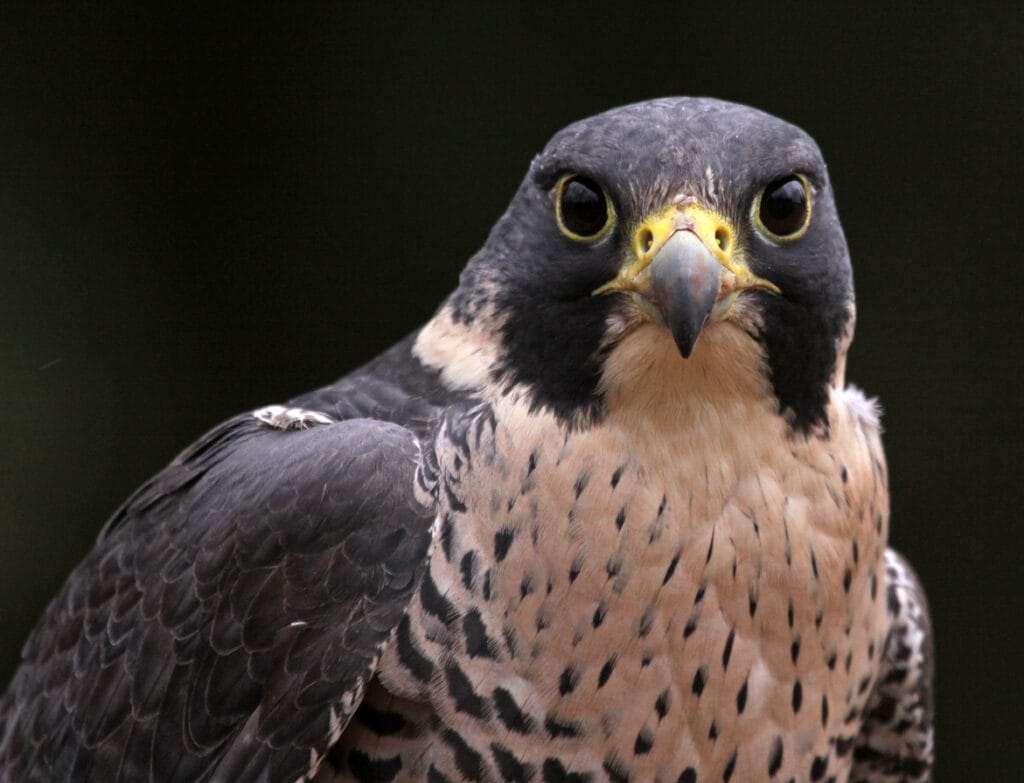
Contrary to popular belief, the Peregrine Falcon is the fastest animal on Earth and not the cheetah. There are also over 23,000 of these bad boys that spread all across the world except the Arctic.
So it’s no wonder they’re popular in Maryland where they often build nests around tall buildings. In addition, their diet exclusively consists of other birds, whether big or small, such as ducks, seagulls, and songbirds.
2. Bald Eagles

The Bald Eagle is most likely the most familiar predatory bird that populates Maryland.
That’s because the state is famous for its many harbors, and the Bald Eagle favors habitats near water bodies where they can prey on fish.
Bald Eagles are also distinctive from other predatory birds by their yellow beaks and white-cap or ‘bald’ heads. However, they only start to look this way when they’re five years old.
3. Ospreys

Similar to Bald Eagles, Ospreys feed mostly on fish. That’s why they also choose to live near where the water is. As a result, you can often spot both species at odds with each other, with the Bald Eagle stealing the Osprey’s hunt.
Ospreys are also commonly mistaken for hawks and are nicknamed Sea-Hawks. But in reality, they’re neither hawks nor eagles and rather have their own bird family (Pandionidae) to which they belong to.
4. Turkey Vultures

These vultures are commonly spread throughout Maryland’s forests. They’re also close in color and beak shape to a wild turkey, hence the name. Plus, Turkey Vultures often fly at low altitudes to be able to smell their prey well.
Author Note: In fact, the Turkey Vulture is known for its incredible sense of smell as it can pick up the scent of dead animals from 8 miles away.
This is also why they usually hang out near highways to feed on roadkill.
5. Black Vultures
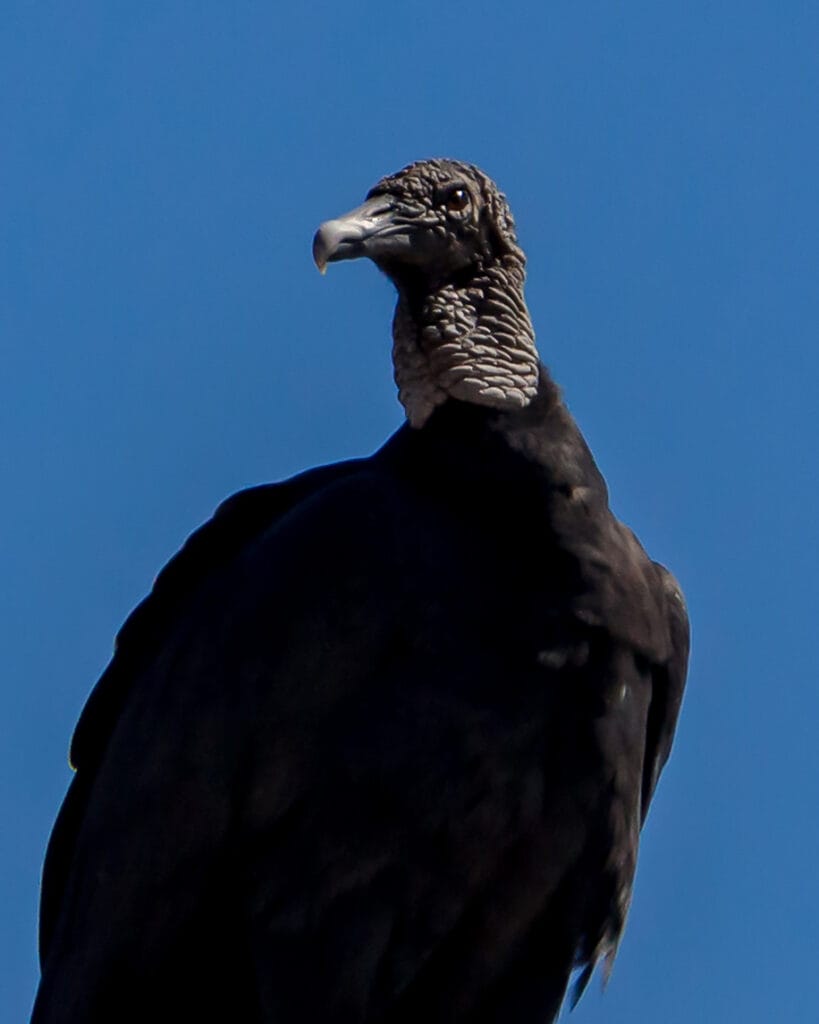
Another common Maryland bird of prey is the Black Vulture. The other most commonly found vulture in Maryland’s open fields and dense forests is the Black Vulture. From its name, you’re right to assume that their whole bodies are black-feathered—except their silver underwings.
Similar to Turkey Vultures, Black Vultures like to feed on the freshly killed meat of mammals such as possums. Livestock, including baby pigs and lambs, is also in a Black Vulture’s diet.
Wrapping Up
Maryland’s birds of prey vary widely. They include countless predatory species from hawks and owls, to vultures and eagles, with each bird being as magnificent as it is deadly.
In the guide above, we’ve gone through the habitat, shape, and feeding habits of the 15 most common birds of prey found in Maryland.
So, make sure to be on the lookout for either one of them next time you’re birdwatching or on a hike in the forest.
FAQ
While the Ferruginous Hawk is the biggest in the U.S., it is the Rough-legged Hawk that is the largest found in Maryland.
The Northern Goshawk can be found in Maryland but there are less than 100 reported sightings on eBird, so it’s pretty rare.
The Turkey Vulture is also known as the Turkey Buzzard and can be found across the state.






